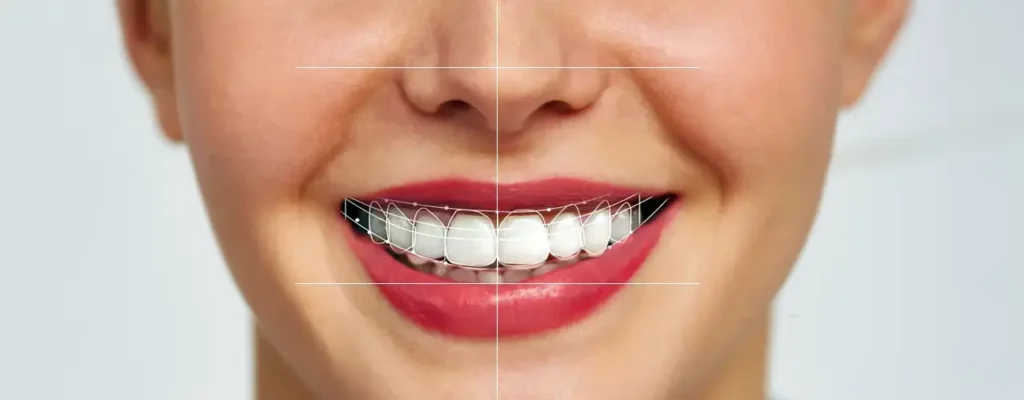Digital Smile Design (DSD) and 3D imaging are transforming cosmetic dentistry, enabling dentists and patients to collaborate more effectively on smile makeovers. These advanced technologies are revolutionizing how dental professionals approach procedures and patient care.
What is Digital Smile Design (DSD)?
Digital Smile Design is a visual and collaborative tool that enhances the dental planning process. With DSD, dentists use high-quality digital photography, videos, and advanced software to analyze your facial features, dental structure, and smile. This information is then used to create a personalized smile design that complements your natural appearance.
Unlike traditional cosmetic dentistry, DSD allows patients to visualize their future smile upfront. With this method, you’ll no longer have to imagine the results or worry about what your new smile will look like—instead, you’ll be able to see a digital preview of your enhanced grin before any procedures begin.
How DSD Works:
- Initial Photos and Videos
The process starts with capturing detailed images of your face, teeth, and smile in motion. This might include close-up photos and short videos of you speaking, smiling, and interacting naturally.
- Digital Analysis and Planning
The dentist uploads these visuals into DSD software, which performs a thorough analysis of your unique features. This enables a precise plan tailored to your facial symmetry, proportions, and aesthetic goals.
- Smile Preview
Using advanced technology, the software creates a virtual mockup of your proposed smile. Whether it’s brighter teeth, straighter alignment, or a more harmonious ratio between gums and teeth, you’ll see exactly how these changes will look.
- Treatment Phase
Once you approve the plan, the dentist uses the digital preview as a guide through the treatment process. This ensures that the procedures align perfectly with the goals outlined by the digital design.
What Role Does 3D Imaging Play?
Digital Smile Design is powerful on its own, but combining it with 3D imaging takes the accuracy and customization to a whole new level. With 3D scanners, dentists can create precise, high-resolution 3D models of your teeth and oral structures in real-time.
3D imaging creates a digital replica of your mouth, capturing tiny details from every angle. This technology offers an unparalleled perspective of your dental anatomy, allowing for more precise planning and execution.
Benefits of 3D Imaging:
- Enhanced Accuracy
Traditional impressions leave room for error, but 3D imaging eliminates inaccuracies by capturing all dimensions of your teeth and gums.
- Comfort and Convenience
Say goodbye to the old-fashioned, gooey dental molds! With 3D scans, the process is quick, non-invasive, and stress-free.
- Seamless Integration with DSD
- 3D imaging complements DSD by adding depth and detail to your smile design. The combination ensures that the planned smile aligns perfectly with your real-world dental structures.
- Efficient Treatment Planning
From dental implants to orthodontic aligners, 3D imaging allows dentists to plan treatments with precision, leading to better outcomes and fewer delays.
The Benefits of Combining DSD and 3D Imaging
When used together, DSD and 3D imaging provide patients with a comprehensive, personalized, and transparent dental experience. Some of the key benefits of combining these technologies include:
- Full Transparency
Traditional dentistry often requires patients to wait until results are fully realized to assess their outcome. With DSD and 3D imaging, you see the plan and the projected results before treatments even begin.
- Personalized Aesthetics
Your smile design isn’t based on generic templates. It’s uniquely tailored to you, taking into account your facial harmony, personality, and functional needs.
- Improved Communication
Dentists can use visuals from DSD and 3D imaging to explain procedures, ensuring you feel confident, informed, and involved in every decision.
- Predictable Outcomes
From the initial smile design to the final product, these technologies ensure exceptional precision throughout every stage of treatment.
- Time-Saving
With accurate digital measurements and precise workflows, treatment planning is faster, reducing the time needed for repeat visits or adjustments.
Who Can Benefit from DSD and 3D Imaging?
These technologies are ideal for anyone looking to improve their smile, but they are especially useful in the following situations:
- Cosmetic Procedures
Whether it’s teeth whitening, veneers like those in Lyndhurst Ohio, or gum contouring, DSD helps patients visualize their potential results.
- Orthodontics
Planning braces or clear aligner treatments becomes seamless with 3D imaging.
- Restorative Dentistry
Complex procedures like dental implants and crowns benefit from the precise data captured through 3D imaging.
- Full Smile Makeovers
Patients considering major transformations can approach their treatment with clarity and confidence.
Is Digital Smile Design Right for You?
If you’re someone who:
- Wants to feel confident about what your new smile will look like before treatment begins,
- Values personalized care that takes your unique features into account, or
- Is looking for precision and predictability in dental procedures,
Conclusion
Digital Smile Design and 3D imaging have truly transformed the way we approach dentistry. By combining these innovative tools, patients receive a one-of-a-kind experience that includes transparency, customization, and results that match or exceed expectations.
Also read-The Cultural Impact of Online Casino Malaysia in a Digital Age
